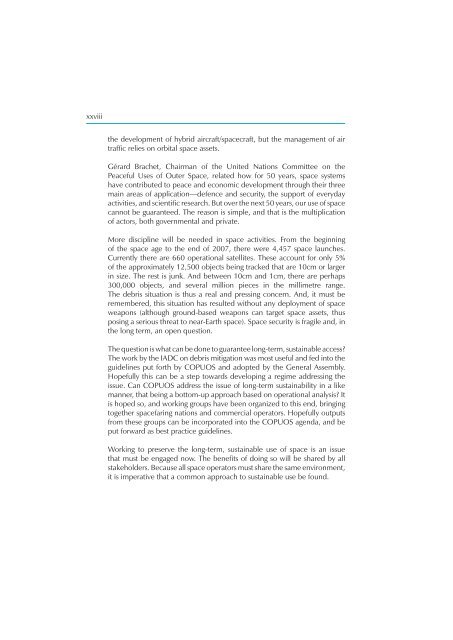Security in Space The Next Generation - UNIDIR
Security in Space The Next Generation - UNIDIR
Security in Space The Next Generation - UNIDIR
You also want an ePaper? Increase the reach of your titles
YUMPU automatically turns print PDFs into web optimized ePapers that Google loves.
xxviii<br />
the development of hybrid aircraft/spacecraft, but the management of air<br />
traffi c relies on orbital space assets.<br />
Gérard Brachet, Chairman of the United Nations Committee on the<br />
Peaceful Uses of Outer <strong>Space</strong>, related how for 50 years, space systems<br />
have contributed to peace and economic development through their three<br />
ma<strong>in</strong> areas of application—defence and security, the support of everyday<br />
activities, and scientifi c research. But over the next 50 years, our use of space<br />
cannot be guaranteed. <strong>The</strong> reason is simple, and that is the multiplication<br />
of actors, both governmental and private.<br />
More discipl<strong>in</strong>e will be needed <strong>in</strong> space activities. From the beg<strong>in</strong>n<strong>in</strong>g<br />
of the space age to the end of 2007, there were 4,457 space launches.<br />
Currently there are 660 operational satellites. <strong>The</strong>se account for only 5%<br />
of the approximately 12,500 objects be<strong>in</strong>g tracked that are 10cm or larger<br />
<strong>in</strong> size. <strong>The</strong> rest is junk. And between 10cm and 1cm, there are perhaps<br />
300,000 objects, and several million pieces <strong>in</strong> the millimetre range.<br />
<strong>The</strong> debris situation is thus a real and press<strong>in</strong>g concern. And, it must be<br />
remembered, this situation has resulted without any deployment of space<br />
weapons (although ground-based weapons can target space assets, thus<br />
pos<strong>in</strong>g a serious threat to near-Earth space). <strong>Space</strong> security is fragile and, <strong>in</strong><br />
the long term, an open question.<br />
<strong>The</strong> question is what can be done to guarantee long-term, susta<strong>in</strong>able access?<br />
<strong>The</strong> work by the IADC on debris mitigation was most useful and fed <strong>in</strong>to the<br />
guidel<strong>in</strong>es put forth by COPUOS and adopted by the General Assembly.<br />
Hopefully this can be a step towards develop<strong>in</strong>g a regime address<strong>in</strong>g the<br />
issue. Can COPUOS address the issue of long-term susta<strong>in</strong>ability <strong>in</strong> a like<br />
manner, that be<strong>in</strong>g a bottom-up approach based on operational analysis? It<br />
is hoped so, and work<strong>in</strong>g groups have been organized to this end, br<strong>in</strong>g<strong>in</strong>g<br />
together spacefar<strong>in</strong>g nations and commercial operators. Hopefully outputs<br />
from these groups can be <strong>in</strong>corporated <strong>in</strong>to the COPUOS agenda, and be<br />
put forward as best practice guidel<strong>in</strong>es.<br />
Work<strong>in</strong>g to preserve the long-term, susta<strong>in</strong>able use of space is an issue<br />
that must be engaged now. <strong>The</strong> benefi ts of do<strong>in</strong>g so will be shared by all<br />
stakeholders. Because all space operators must share the same environment,<br />
it is imperative that a common approach to susta<strong>in</strong>able use be found.








